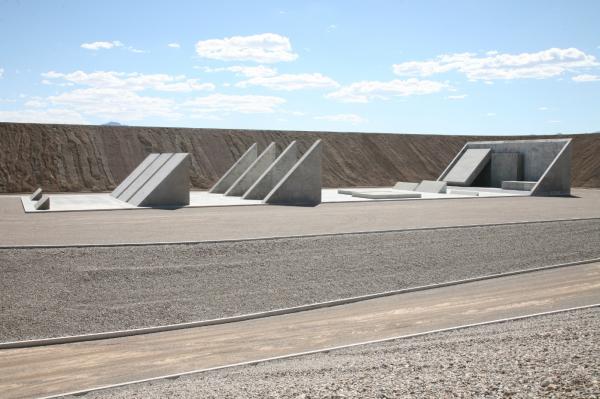There has been an ongoing campaign in Nevada in the past few years to get a stretch of land, known as Basin and Range, designated with Monument status. This would preserve the land—which has been threatened in the past—and keep it from being developed into a missile site, a location for oil and gas exploration, and a nuclear waste rail line. While the outcome of this issue has clear meaning to residents of the state and defenders of the environment, it also has significant cultural impact, concerning objects both ancient and contemporary.
Located in Garden Valley, Nevada, Michael Heizer’s City is one of the most significant works of art in the United States. Begun by Heizer in 1972, the project is now in its final stage of completion. It will, in the future, be accessible by the public. Heizer of course has some special significance to Los Angeles, as two significant works belong to L.A. museums. Heizer’s incredible Double Negative, which exists in another part of the Nevada desert, is in MOCA’s collection. (MOCA director Philippe Vergne recently visited the work and shared his experience on Instagram). LACMA installed Levitated Mass in 2012, as so many people witnessed firsthand when we moved “the rock” from Jurupa Valley to LACMA (now the subject of a feature-length documentary). Beyond Los Angeles, Heizer is simply one of the most significant living artists in the world, thanks to his pioneering work in what became known as Land Art.
Sign the petition to protect Michael Heizer's City and the Basin and Range.
City is Heizer’s magnum opus. Although it is not yet finished, images of City have circulated for decades. As with many of Heizer’s greatest works, the sculpture is incomplete without the surrounding landscape. The solitude of City is part of its power. To have the surrounding land developed into anything would severely impact Heizer’s work. To see the land developed into a site for military, energy, or waste purposes, would ruin it forever. After 43 years of work, can it really be destroyed like this?
Beyond Heizer’s artwork, protecting Basin and Range has other critical cultural and scientific ramifications. The area contains ancient lithic scatters, early Native American trails, and rock art dating back thousands of years as well as wildlife unique to the area and important geologic features. The conservation proposal has the potential to provide important information about use of this portion of the Basin and Range province from the Paleoindian period through the present.
For almost 20 years, as director of both Dia Art Foundation and LACMA, Michael Govan has tried to educate people about City and bring this not only to the attention of the wider public but also to Washington D.C., as the land surrounding Heizer’s property is all public land. As the possibility for protecting Basin and Range comes close to a reality, LACMA and other museums around the country are hoping to bring attention to the positive cultural impact protecting this land would have. Please take a few moments to sign this petition to voice your support for protecting this land.





